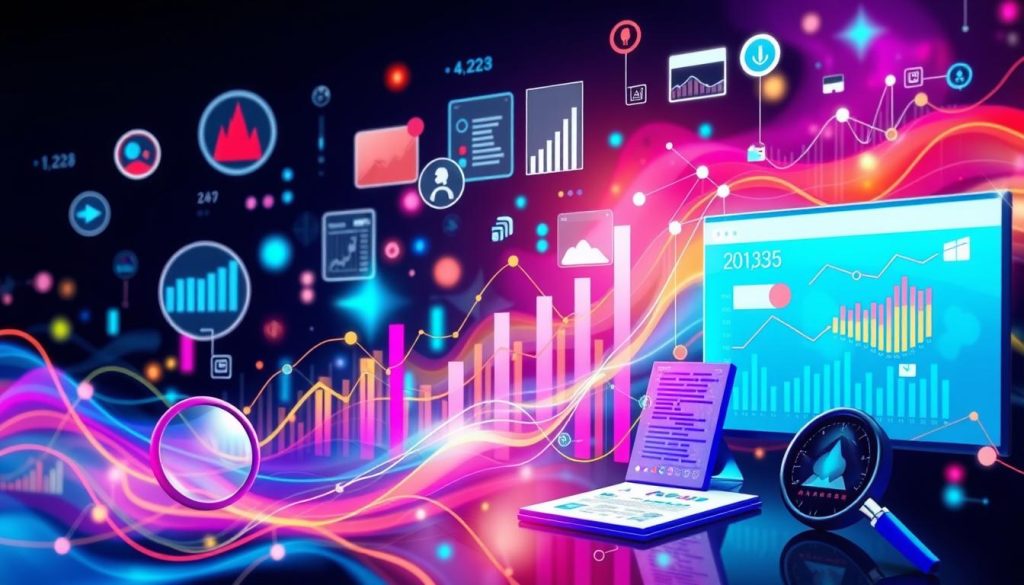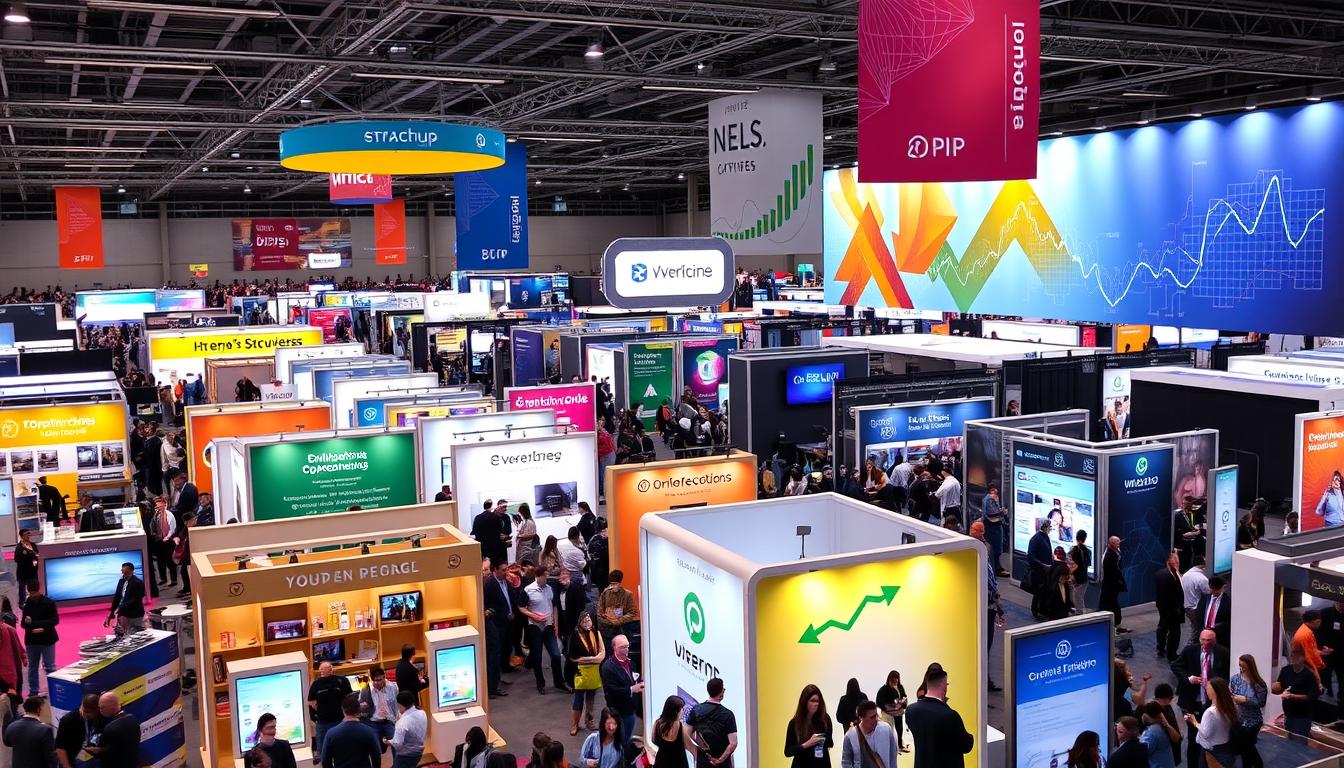Tradeshows remain a vital part of event planning and exhibitor strategy. To make the most of these opportunities, it’s crucial to know how to optimize your tradeshow strategy. With the right approach, you can boost your brand visibility, generate quality leads, and create lasting business relationships.
In today’s competitive business landscape, a well-crafted tradeshow strategy can set you apart from the crowd. By focusing on engagement tactics, leveraging technology, and maximizing return on investment, you can transform your tradeshow presence into a powerful marketing tool.
Key Takeaways
- Set clear goals for your tradeshow participation
- Embrace digital tools to enhance your exhibitor strategy
- Focus on creating meaningful connections with attendees
- Utilize data analytics to measure and improve performance
- Align your tradeshow strategy with overall marketing objectives
- Implement effective follow-up processes for lead conversion
Understanding the Modern Tradeshow Landscape
The tradeshow industry has undergone significant changes in recent years. As businesses adapt to new technologies and consumer behaviors, the landscape of tradeshows continues to evolve. Let’s explore the current trends, digital impacts, and success metrics shaping today’s tradeshow environment.
Current Industry Trends and Statistics
Tradeshows remain a vital platform for lead generation and business networking. Recent data shows a surge in virtual and hybrid events, with 67% of marketers planning to increase their investment in these formats. The integration of marketing automation tools has also become crucial, enabling exhibitors to streamline their processes and enhance attendee engagement.
Impact of Digital Transformation on Tradeshows
Digital transformation has revolutionized the tradeshow experience. Augmented reality (AR) and virtual reality (VR) technologies now offer immersive product demonstrations, while AI-powered chatbots provide instant attendee support. These innovations have expanded the reach of tradeshows beyond physical boundaries, creating new opportunities for global participation and data-driven insights.
Key Performance Indicators for Success
Measuring tradeshow success requires tracking specific KPIs. Here are the most critical metrics:
| KPI | Description | Importance |
|---|---|---|
| Lead Quality | Measure of how likely a lead is to convert | High |
| ROI | Return on investment for tradeshow participation | Critical |
| Engagement Rate | Level of interaction with booth or virtual content | Medium |
| Sales Pipeline Impact | Influence on future sales opportunities | High |
By focusing on these KPIs, businesses can optimize their tradeshow strategies and maximize their impact on lead generation and overall marketing goals.
Pre-Show Planning and Goal Setting
Successful event planning starts with a solid pre-show strategy. Crafting clear objectives, allocating budgets wisely, and developing a timeline are crucial steps for exhibitors aiming to boost brand awareness at tradeshows.
Defining Clear Objectives
Start by setting specific, measurable goals for your tradeshow participation. These might include:
- Generating a certain number of qualified leads
- Launching a new product or service
- Strengthening relationships with existing clients
- Enhancing overall brand awareness
Budget Allocation Strategies
Effective exhibitor strategy hinges on smart budget allocation. Consider these key areas:
| Expense Category | Percentage of Budget | Key Considerations |
|---|---|---|
| Booth Space | 30-40% | Location, size, visibility |
| Exhibit Design | 15-20% | Graphics, layout, interactivity |
| Marketing Materials | 10-15% | Brochures, giveaways, digital content |
| Staff Expenses | 15-20% | Travel, accommodation, training |
| Technology | 5-10% | Lead capture devices, displays |
Timeline Development and Milestones
Create a detailed timeline to guide your event planning process. Key milestones might include:
- 6 months out: Finalize booth design and layout
- 4 months out: Develop marketing materials
- 2 months out: Train staff on booth protocols
- 1 month out: Confirm all logistical details
By following these pre-show planning steps, you’ll set a strong foundation for tradeshow success and maximize your brand awareness opportunities.
Leveraging Marketing Automation Tools
Marketing automation tools are game-changers for tradeshow success. These powerful systems streamline processes, boost efficiency, and maximize lead generation potential. Let’s explore how to harness their power for your next event.
CRM Integration Solutions
Integrating customer relationship management (CRM) systems with tradeshow activities is crucial. This integration allows for seamless data flow, ensuring no lead slips through the cracks. CRM tools help track interactions, store contact info, and provide valuable insights for follow-ups.
Lead Scoring Systems
Lead scoring is vital for prioritizing prospects. It helps sales teams focus on high-potential leads, increasing conversion rates. Here’s a simple lead scoring model:
| Action | Score |
|---|---|
| Booth Visit | 5 points |
| Product Demo | 10 points |
| Email Sign-up | 15 points |
| Meeting Request | 20 points |
Automated Follow-up Sequences
Automated follow-ups ensure timely and consistent communication with leads. Set up email sequences to nurture relationships post-event. Clean your email lists regularly to maintain high engagement rates.
By leveraging these marketing automation tools, you’ll transform your tradeshow strategy, boosting lead generation and ROI. Remember, the key is to integrate these tools seamlessly into your overall marketing plan for maximum impact.
Strategic Lead Generation Tactics
Mastering lead generation at tradeshows is crucial for business success. By employing smart tactics, companies can maximize their return on investment and build lasting relationships with potential clients.
Digital Lead Capture Methods
Gone are the days of paper business cards. Modern tradeshows use digital tools to capture leads efficiently. QR codes, mobile apps, and badge scanners streamline the process, allowing for quick data collection and easy follow-up.

Qualification Processes
Not all leads are created equal. Implementing a solid qualification process helps identify the most promising prospects. Use short surveys or chatbots to gather key information and score leads based on their potential value to your business.
Real-time Lead Distribution
Speed is essential in lead conversion. Real-time distribution systems send qualified leads to the right team members instantly. This quick action can make the difference between closing a deal and losing out to competitors.
| Lead Generation Tactic | Benefits | Challenges |
|---|---|---|
| Digital Lead Capture | Fast data collection, reduced human error | Requires tech-savvy staff, potential connectivity issues |
| Lead Qualification | Focuses efforts on high-value prospects | Designing effective qualification criteria |
| Real-time Distribution | Immediate follow-up, increased conversion rates | Needs robust CRM integration, staff training |
By leveraging these strategic lead generation tactics, businesses can turn networking opportunities into valuable data-driven insights. This approach not only enhances the tradeshow experience but also contributes to long-term business growth.
Maximizing Networking Opportunities
Tradeshows offer a goldmine of networking opportunities. To make the most of these events, focus on building genuine connections. Start conversations by asking about others’ work and sharing your own experiences. This approach helps create a foundation for future customer relationship management.
Leverage social events to expand your network. Attend after-hours gatherings, industry mixers, and sponsored parties. These relaxed settings often lead to more candid discussions and stronger relationships. Remember to bring business cards and be ready to exchange contact information.
Use social media to enhance your networking efforts. Create event-specific hashtags and engage with other attendees online. This strategy can boost your brand awareness and help you connect with potential leads before, during, and after the tradeshow.
“Networking is not about just connecting people. It’s about connecting people with people, people with ideas, and people with opportunities.” – Michele Jennae
To maximize your networking success, consider these strategies:
- Set specific networking goals for each day of the event
- Practice your elevator pitch to clearly communicate your value proposition
- Follow up with new contacts within 48 hours of meeting them
- Use a CRM system to track interactions and nurture relationships
| Networking Activity | Benefits | Best Practices |
|---|---|---|
| Attending keynote speeches | Access to industry leaders, shared learning experiences | Ask thoughtful questions, engage in post-speech discussions |
| Participating in workshops | Skill development, peer-to-peer connections | Contribute to group activities, exchange contact info with peers |
| Exhibitor booth visits | Product knowledge, potential partnerships | Schedule appointments, prepare relevant questions |
By focusing on these networking strategies, you’ll create valuable connections that can lead to long-term business relationships and increased brand awareness. Remember, effective networking is about quality over quantity, so prioritize meaningful interactions at every opportunity.
Data Collection and Analysis Strategies
Smart data collection and analysis are key to tradeshow success. By tracking the right metrics and using powerful analytics tools, businesses can gain valuable data-driven insights to improve their marketing automation and lead generation efforts.

Key Metrics to Track
To measure tradeshow performance effectively, focus on these crucial metrics:
- Booth traffic
- Lead quality scores
- Conversion rates
- Sales pipeline growth
- Social media engagement
Analytics Tools and Platforms
Leverage advanced analytics platforms to process and visualize your data. Tools like Google Analytics, Salesforce, and marketing automation software can help you track visitor behavior, manage leads, and optimize your tradeshow strategy.
ROI Measurement Techniques
Calculate your return on investment by comparing tradeshow costs to the value of new leads and deals. Use this formula:
ROI = (Value of Leads – Total Costs) / Total Costs x 100
By applying these data collection and analysis strategies, you’ll gain actionable insights to refine your lead generation tactics and boost overall tradeshow performance.
Post-Show Follow-up and Nurturing
After the tradeshow ends, your work is far from over. Effective post-show follow-up and lead nurturing are crucial for turning those valuable connections into sales. Let’s dive into strategies that will help you make the most of your tradeshow efforts.
Immediate Response Protocols
Quick action is key when following up with leads. Set up automated emails to thank attendees for visiting your booth. Include personalized content based on their interests. This shows you value their time and keeps your brand fresh in their minds.
Lead Nurturing Campaigns
Create targeted campaigns to nurture your leads. Use customer relationship management tools to segment your audience. Send relevant content, such as product demos or case studies, to keep them engaged. Remember, nurturing is about building relationships, not just selling.
Converting Leads to Sales
Turn those warm leads into hot sales with these tactics:
- Use lead scoring to identify high-potential prospects
- Offer personalized demos or consultations
- Provide exclusive post-show discounts
- Follow up with phone calls for high-value leads
Implement marketing automation to streamline your follow-up process. This ensures no lead falls through the cracks and frees up your team to focus on closing deals.
Remember, successful lead generation doesn’t end at the tradeshow. By following these strategies, you’ll maximize your return on investment and turn those promising leads into loyal customers.
Integration with Overall Marketing Strategy
A smart exhibitor strategy goes beyond the tradeshow floor. It’s about weaving your tradeshow efforts into your broader marketing tapestry. By aligning your booth presence with your overall goals, you create a powerful brand message that resonates across all channels.
Brand awareness isn’t just a buzzword – it’s the heartbeat of your marketing efforts. Your tradeshow booth should echo the same tone and style as your website, social media, and other marketing materials. This consistency helps build trust and recognition with your audience, making your brand unforgettable.
Data-driven insights from tradeshows are gold mines for your entire marketing strategy. The feedback you gather, the connections you make, and the trends you spot can shape your future campaigns. Omnily.io’s marketing automation tools can help you analyze this valuable data and use it to fine-tune your approach across all marketing channels.
Remember, your tradeshow strategy isn’t an island. It’s a bridge connecting your brand to new opportunities. By integrating it seamlessly with your overall marketing plan, you’ll create a cohesive, powerful message that drives your business forward.






